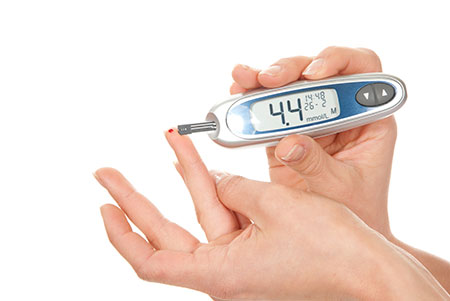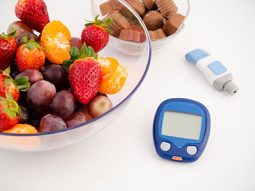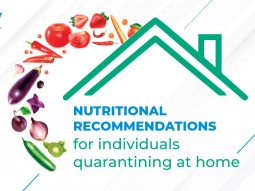Having diabetes means the amount of sugar (glucose) in your blood is higher than it should be. Keeping your blood glucose in your target range can prevent or delay the health problems caused by diabetes. Most of the steps needed to take care of diabetes are things you can do yourself:
- Use a meal plan;
- Be physically active;
- Take your medicines;
- Try to reach your blood glucose targets most of the time;
- Keep track of your blood glucose numbers using the results from your daily blood glucose testing and your HbA1c check.
What are the symptoms of diabetes?
The common symptoms of undiagnosed diabetes are:
- Polydipsia (abnormally great thirst)
- Polyuria (passing of an excessive quantity of urine)
- Polyphagia (excessive eating)
- Fatigue
- Weight loss
- Blurred vision
- Slow healing
- Genital itching
- Dizziness
- Nausea
- Dry mouth
- Leg pain.

How fast do the symptoms of diabetes develop?
Knowing and recognising the symptoms of diabetes is essential. Catching diabetes at an early stage can delay or prevent the development of serious complications.
Type 1 diabetes
In type 1 diabetes, the signs and symptoms can develop very quickly, and can develop significantly over the course of weeks or even days – particularly in children or adolescents.
In children and younger adults, signs such as increased urination, increased thirst, tiredness and sudden weight loss tend to be the most noticeable symptoms.
Having history of type 1 diabetes in your family increases the chances of developing type 1 diabetes.
Type 2 diabetes
Type 2 diabetes tends to develop more slowly, usually over a period of months or even years. It can also lead on from pre-diabetes.
The symptoms can appear very gradually, which can make spotting the signs more difficult.
It is not uncommon for people to live with type 2 diabetes for years without being aware of their condition. These cases of undiagnosed diabetes may sometimes only be picked up during a routine medical check-up
What are the blood glucose targets for people with diabetes?
Targets set by the American Diabetes Association (ADA) for non-pregnant adults are listed below. Talk with your health care team about your personal goals.
| ADA TARGETS FORBLOOD GLUCOSE | MY USUAL RESULTS | MY GOALS |
| Before meals:70 to 130 mg/dL | ______ to______ | ______ to______ |
| 2 hours after the start of a meal:below 180 mg/dL | below______ | below______ |
How can I keep track of my blood glucose levels?
Checking your blood glucose will tell you whether you are reaching your blood glucose targets. There are two ways to do it:
- Use a blood glucose meter to learn what your blood glucose is at the moment;
- Get an HbA1c check at least twice a year.
How to use a blood glucose meter?
Many people use their meter to check their blood glucose several times a day. Talk with your health care team about when and how often to check your blood glucose. They can give you a record book where you can write down your blood glucose numbers. You can learn how to use your numbers to make choices about food, physical activity, and medicines.
Your results tell you how well your diabetes care plan is working. You will be able to look at your record book and see patterns (look for similar results over and over). Looking at these patterns can help you and your health care team fine-tune your diabetes care plan in order to reach your targets.
What is the HbA1c test?
The HbA1c test, also known as the haemoglobin A1c or glycated haemoglobin test, is an important blood test that gives a good indication of how well your diabetes is being controlled.
HbA1c occurs when haemoglobin, the oxygen-carrying protein in red blood cells, becomes bonded with glucose in the bloodstream. The bonding with glucose is called glycation.
The higher a person’s blood glucose levels have been, the higher the number of red blood cells that will have become glycated, and therefore the higher HbA1c level they will have. Note that red blood cells exist in the body for around three months, therefore an HbA1c levels generally reflects a person’s blood glucose levels over the previous 8-12 weeks.
Normal HbA1c is below 6%; HbA1c level between 6% and 6.4% indicates what is called “pre-diabetes”, when the level is 6.5% or over you have type 2 diabetes.
Hb1Ac should be checked at least twice a year, if it remains too high you may need a change in your diabetes care plan
People with diabetes who reduced their HbA1c by less than 1% can cut their risk of dying within five years by 50%, according to Swedish research presented at the annual meeting of the European Association for the Study of Diabetes in September 2012.
What if my blood glucose is often too high?
High blood glucose occurs when the body has too little insulin or when the body cannot use insulin properly.
Other possible causes for high blood glucose include:
- A meal or snack with more food or more carbohydrates than usual
- Physical inactivity
- Not enough diabetes medicine
- Side effects of other medicines
- Infection or other illness
- Changes in hormone levels, such as during menstrual periods,
What is hypoglycaemia?
Hypoglycaemia (commonly called “hypo”) occurs when blood glucose levels fall below 4 mmol/L (72mg/dL).
Whilst many of us think of diabetes as being a problem of high blood sugar levels, some people with diabetes take medication that can also cause their sugar levels to go too low and this can become dangerous.
Being aware of the early signs of hypoglycaemia will allow you to treat your low blood glucose levels quickly – in order to bring them back into the normal range.
It is also recommended to make close friends and family aware of the signs of hypoglycaemia in case you fail to recognise the symptoms.
What are the symptoms of hypoglycaemia?
Typical signs of hypoglycaemia include:
- Feeling suddenly tired or weak
- Having difficulty concentrating
- Exaggerated mood changes
- Feeling dizzy
Symptoms of hypoglycaemia can also include:
- Being pale
- Feeling hungry
- A higher heart rate than usual
- Blurred vision
- Confusion
- Convulsions
- Loss of consciousness
- And in extreme cases, coma.
Most people experience some warnings before the onset of hypoglycaemia. However, some diabetics may experience little or no warning before the onset of sudden or severe hypoglycemia.
Who is at risk of hypos?
Whilst low blood sugar can happen to anyone, dangerously low blood sugar can occur in people who take the following medication:
- Insulin
- Sulphopnylureas (such as glibenclamide, gliclazide, glipizide, glimepiride, tolbutamide)
- Prandial glucose regulators (such as repaglinide, nateglinide).
It is important to know whether your diabetes medication puts you at risk of hypos. If you are not sure whether your diabetes medication can cause hypos, read the patient information leaflet that comes with each of your medications or ask your doctor.
What are the causes of hypoglycaemia?
Whilst medication is the main factor involved in hypoglycaemia within people with diabetes, a number of other factors can increase the risk of hypos occurring.
Factors linked to a greater risk of hypos include:
- Too high a dose of medication (insulin or hypo-causing medications)
- Delayed meals
- Exercise
- Alcohol.
You can take steps to minimise the risk of these factors causing hypos.
How serious is hypoglycaemia?
Hypoglycemic episodes can range from mild to severe.
Mild hypoglycemia can usually be treated by the individual and are to be expected to some degree in people on insulin. Mild hypos are not associated with significant long term health problems unless they are occurring very regularly or for long periods of time.
Severe hypoglycemia, however, will require treatment from someone else and may require an ambulance. Severe hypos can lead to immediate danger if not treated immediately. Whilst rare, severe hypos can potentially lead to coma and death.
How do I treat a hypo?
Hypoglycemia can quickly become dangerous if left untreated. It is thus important that as soon as you notice or confirm you are hypo you treat the hypo immediately.
To treat the hypo, you need to take about 15 to 20 grams of fast-acting carbohydrate. Fast-acting carbohydrates are foods that are easily converted to sugar in the body, such as candy, fruit juice, regular — not diet — soft drinks, or glucose tablets. Foods containing fat or protein are not good treatments for hypoglycaemia, because protein and fat can slow the body’s absorption of sugar
Glucose tablets are ideal as they act very quickly and will take you out of the hypo quicker. They are also relatively easy to judge how much sugar you are taking.
Sugary drinks (Coke, Pepsi, etc.) can sometimes be a little more difficult to judge how much sugar you are taking but they’re still a good source of sugar in an emergency.
15-20g of sugar can be found in:
- 160mL of sugary cola or lemonade
- 200mL (a small carton) of fruit juice
- 1 tablespoon of sugar or honey
- 5 to 7 pieces of hard candy.
After 15 minutes, check your blood glucose again. If it’s still below 70 mg/dL, eat another carb choice. Repeat these steps until your blood glucose is at least 70 mg/dL.
Once the blood sugar levels are back to normal, it’s important to have a snack or meal to help stabilise your blood sugar. This also helps the body replenish glycogen stores that may have been depleted during the hypoglycaemia.
If your symptoms are more severe, impairing your ability to take sugar by mouth, you may need an injection of glucagon or intravenous glucose. Do not give food or drink to someone who is unconscious, as he or she may aspirate these substances into the lungs.
What should I do about frequent low blood glucose?
If your blood glucose is often low, you may need a change in your meal plan, physical activity, or diabetes medicines. Keep track of when you have had low blood glucose events. Note possible causes, such as unplanned physical activity. Then talk it over with your doctor.
If you’re prone to severe episodes of hypoglycemia, ask your doctor if a home glucagon kit might be appropriate for you. In general, people with diabetes who are treated with insulin should have a glucagon kit for low blood sugar emergencies. Family and friends need to know where to find the kit, and need to be taught how to use it before an emergency occurs.
This information is for education purposes and is not intended to replace a consultation with specialist doctor. If you have questions concerning your health condition, please discuss them with your doctor.

 Vi
Vi 












